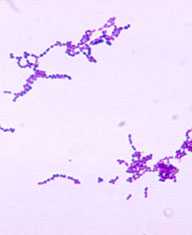Starting an Investigation of a GAS Cluster

Recommended steps for local and state health agencies involved in public health investigations of GAS infections
- Confirm diagnoses and look for additional invasive GAS cases.
- Collect clinical and demographic data on cases, e.g., age, sex, disease syndrome, setting (community, hospital or other facility).
- Investigate epidemiologic links among cases.
- Determine if the cluster is facility-based.
- Discuss with local and state public health authorities whether urgent public health action is needed.
- Ask laboratories to save GAS isolates.
- Review previous GAS surveillance data in region.
Settings requiring urgent public health action
- Postpartum and post-surgical GAS infections (see Prevention of Invasive Group A Streptococcal Disease among Household Contacts of Case Patients and among Postpartum and Postsurgical Patients: Recommendations from the Centers for Disease Control and Prevention. Clinical Infectious Disease October 15, 2002, Vol. 35, Pages 950-959.)
- Outbreaks of rheumatic fever
- Clusters in military institutions
- Clusters in hospitals or long-term care facilities
- Outbreaks of invasive disease in child care centers and other school settings
- Outbreaks of invasive disease among young children following varicella (Chicken pox) infections
These and other settings requiring urgent public health action should be discussed with your state or local public health partners. A single case of postpartum or post-surgical GAS infection requires prompt epidemiologic investigation; assessment of potential nosocomial spread from an asymptomatic carrier may be required. Close contact facilitates disease transmission; special interventions and precautions may be necessary to control disease spread in group settings.
Guidelines for invasive group A streptococcal disease among household contacts
- For household contacts of persons with invasive GAS infection, routine screening for GAS colonization and chemoprophylaxis is not recommended
- Physicians and public health officials may choose to offer chemoprophylaxis to household contacts who are at increased risk of GAS disease.
- Page last reviewed: December 10, 2007
- Page last updated: December 10, 2007
- Content source:


 ShareCompartir
ShareCompartir